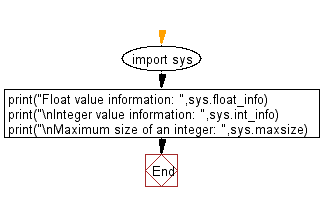Python: Determine the largest and smallest integers, longs, floats
Max and Min of Number Types
Write a Python program to determine the largest and smallest integers, longs, and floats.
Sample Solution:
Python Code:
# Import the sys module to access system-related information.
import sys
# Print information about the float data type.
print("Float value information: ", sys.float_info)
# Print information about the integer data type (Note: there is no sys.int_info, this is incorrect).
print("\nInteger value information: ", sys.int_info)
# Print the maximum size of an integer that can be represented on the current system.
print("\nMaximum size of an integer: ", sys.maxsize)
Sample Output:
Float value information: sys.float_info(max=1.7976931348623157e+308, max_exp=1024, max_10_exp=308, min=2.2250
738585072014e-308, min_exp=-1021, min_10_exp=-307, dig=15, mant_dig=53, epsilon=2.220446049250313e-16, radix=2
, rounds=1)
Integer value information: sys.int_info(bits_per_digit=30, sizeof_digit=4)
Maximum size of an integer: 9223372036854775807
Flowchart:

For more Practice: Solve these Related Problems:
- Write a Python program to find the minimum and maximum possible float values in Python.
- Write a Python program to check if an integer is greater than the maximum representable integer in Python.
- Write a Python program to determine the range of floating-point precision in Python.
- Write a Python program to compare the smallest and largest values of int, float, and complex types.
Go to:
Previous: Write a Python program to empty a variable without destroying it.
Next: Write a Python program to check if multiple variables have the same value.
Python Code Editor:
What is the difficulty level of this exercise?
Test your Programming skills with w3resource's quiz.
